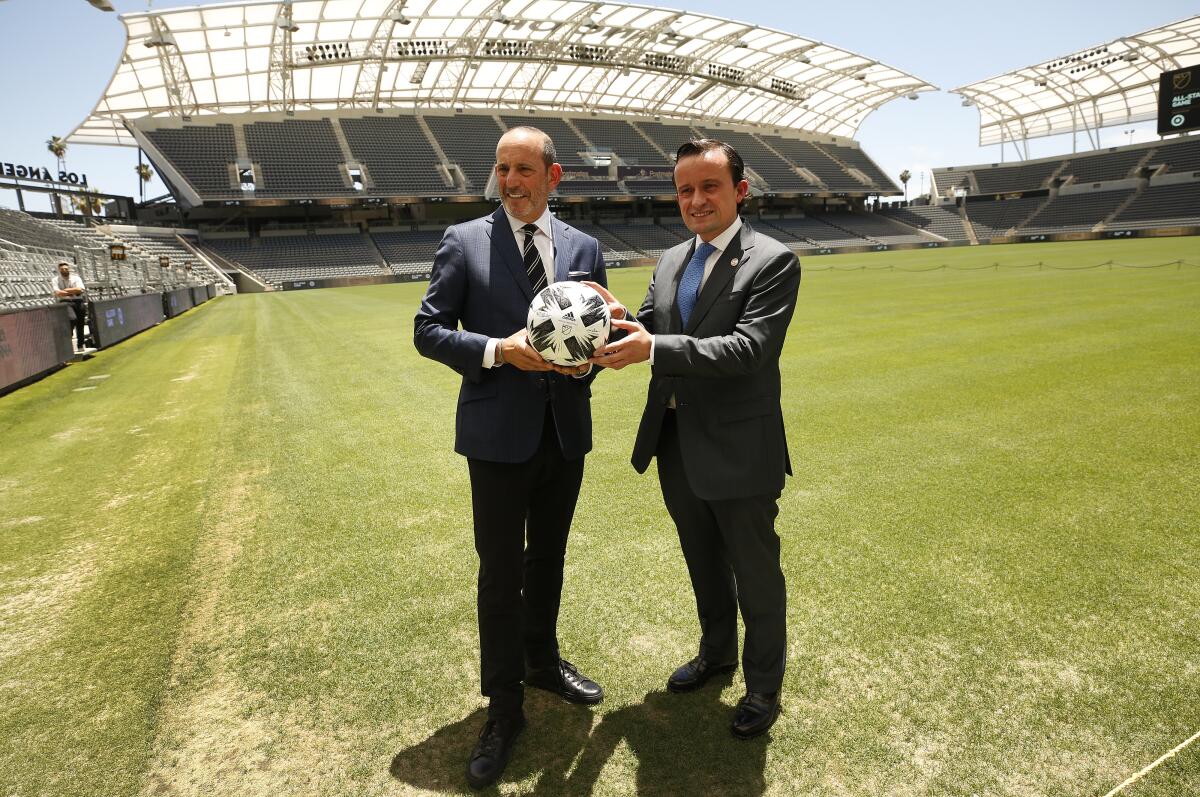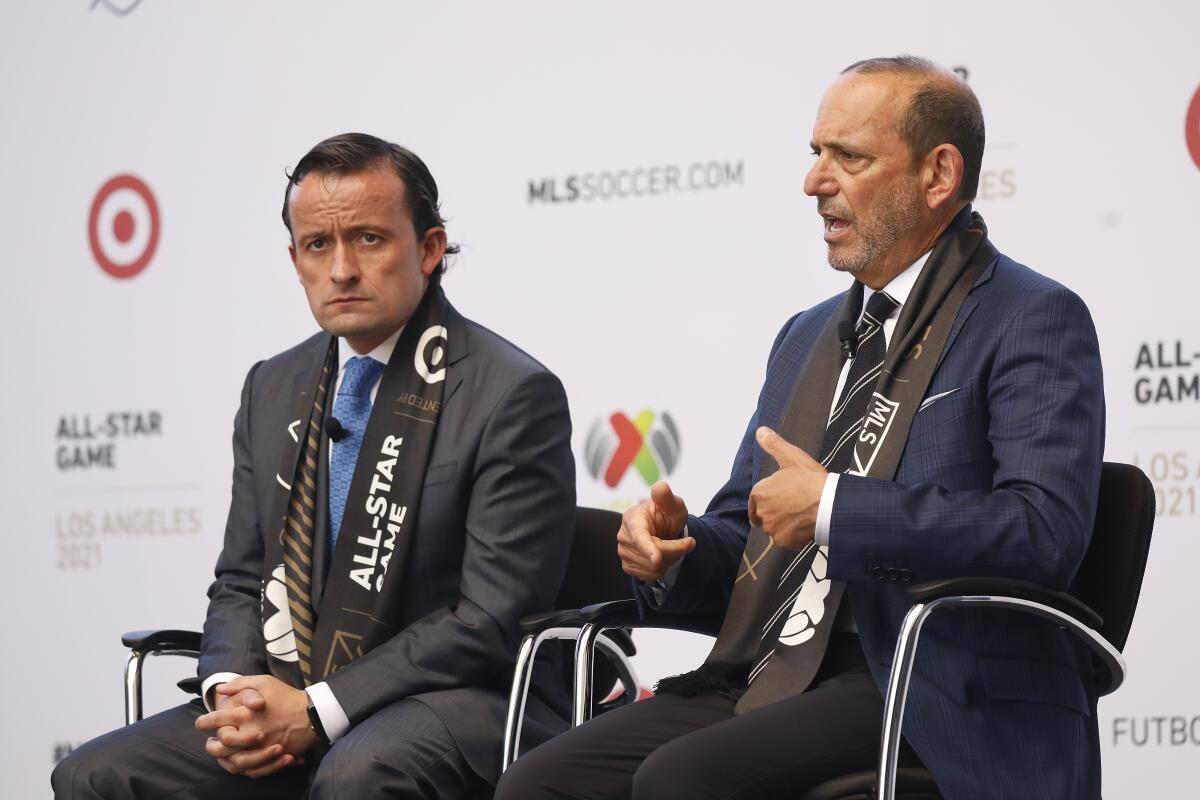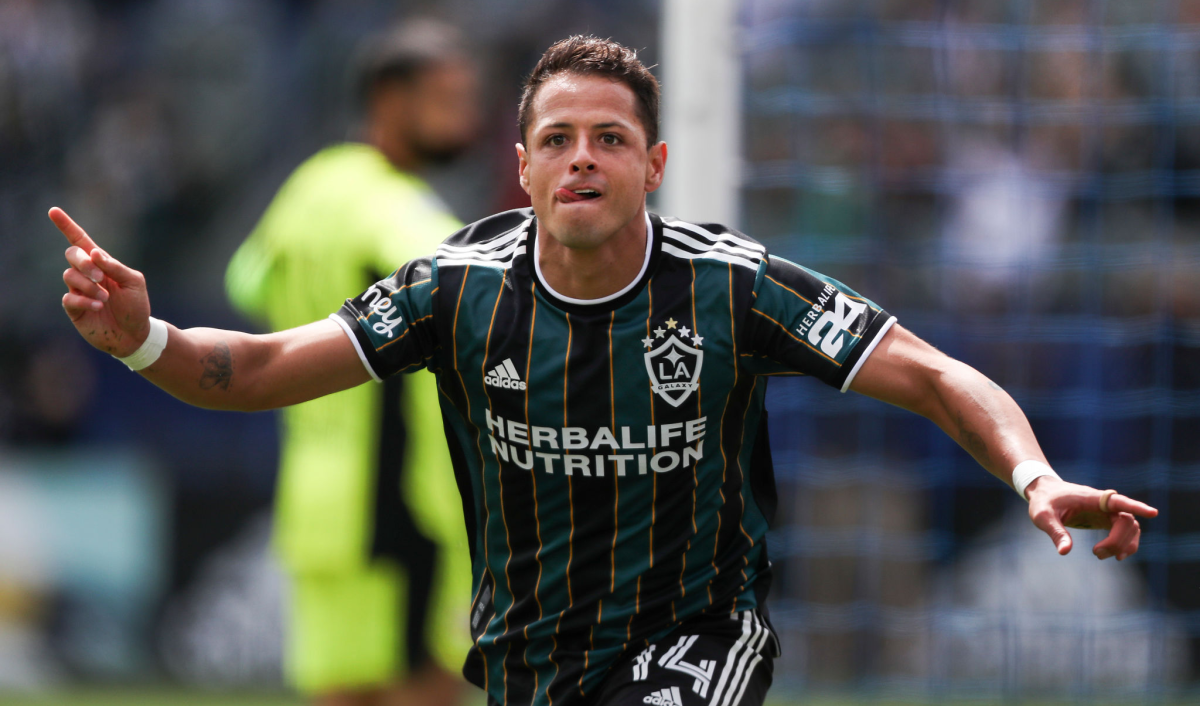Soccer newsletter: Liga MX president Mikel Arriola turns to MLS to spur growth

- Share via
Hello and welcome to the L.A. Times soccer newsletter. I’m Kevin Baxter, the Times’ soccer writer and we begin today with Mexico’s Liga MX.
The league’s new president is Mikel Arriola, a London-trained economist with a Juris Masters from the University of Chicago. He came to soccer from the public sector, having served as director general of Mexico’s Social Security Institute where he took Latin America’s largest healthcare provider from debt to profit for the first time in nearly four decades.
Admittedly, he doesn’t know the sport as intimately as many former presidents, but that’s partly the point. The league has long gotten the soccer part of its mission right. Where it needs is help is with the economic part because, for all its success on the field, the growth of Liga MX is lagging well behind that of MLS, among others.
Arriola was hired in December to turn that around.
“One of the key factors for expansion in our league is expansion internationally,” he said last week. “You can see other leagues that have grown two digits. We want to grow two digits like MLS.”
Expanding the league’s ties with MLS, Arriola believes, is the best way to do that, which is why he was in Los Angeles to introduce a joint MLS-Liga MX All-Star Game in August, the latest in a series of partnerships between the leagues.
“We have to be able to grow in our North American market. This market is huge for us. And it’s unique,” said Arriola, who has studied and admires MLS’ growth. “One of our main strategies is to grow in the same terms of other leagues, accumulating the fan base in the U.S. of MLS, growing with them and expanding our properties with MLS.”
Arriola, a serious, no-nonsense guy, ran for mayor of Mexico City on the ticket of Mexico’s Institutional Revolutionary Party (PRI) in 2018 and finished a distant third. In conversation he frequently cites numbers and mathematical trends to support his arguments — and those numbers have convinced him Liga MX has long been under-performing.
The 18-team league drew about 23,000 fans a game in 2019, the last year before COVID-19 forced teams to limit attendance. That was among the highest average figure in world soccer, behind four of Europe’s five major leagues and just ahead of MLS. Arriola said the value of the league’s players also ranked among the top 10 globally and Liga MX’s TV ratings have dwarfed MLS from the start, making it the most-watched soccer league in North America.
Given those numbers, Arriola said the league should be growing twice as fast as it has been. Instead, it remains a sleeping giant.
“We have a huge capacity as a league,” he said. “At the end of the day the economics are not the principal thing or the most important thing. But economics help. If we generate more resources, we can give more resources to our teams to help them acquire better players.
“I think Mexico has the capacity to grow in two digits annually. We have been growing 5% a year in the last maybe 12 years. We know that we can grow more than that.”

That will happen quickest, he said, by looking north rather than south because MLS is expanding far more rapidly than leagues in South America.
“If you combine MLS and the Mexican league, they have grown 150% in the last 12 years,” he said referring to the value of the two leagues’ players, which Transfermarkt puts at a combined $1.51 billion. “South America, they have grown 1%.”
MLS commissioner Don Garber credited improved governance in Liga MX, at the league and club level, for the improvement. That, too, has been a focus of Arriola, who told The Athletic it was his success at sorting out the Social Security Institute that got him the Liga MX job in the first place.
“It was able to go from red to black for the first time in 35 years,” Arriola told the website. “I believe that was the type of profile that Liga MX searched for in order to undergo an organized transition. Someone who understood this practice of diagnosis, discernment and execution in relation to the types of measures that will benefit the league and an industry that’s worth $2 billion.”
In the last three years, Liga MX and MLS have partnered in two tournaments — the Campeones Cup, featuring the respective league champions, and the eight-team Leagues Cup. Now comes the Aug. 25 All-Star Game at Banc of California Stadium, matching the best players from MLS against their Liga MX counterparts. That level of cooperation has led to questions about a possible merger, similar to the one approved last spring by Belgium’s Pro League that would combine it with the Dutch Eredivisie.
Garber has long pushed back on those rumors while, at the same time, pushing for more collaboration with the Mexican league, partly as a way for MLS to make inroads into a U.S. Hispanic market that remains fiercely loyal to Liga MX.
“If it makes sense at the right time, then we’ll take that step,” Garber said of a merger.
In the meantime, expect Arriola to continue trying to get Liga MX’s house in order while continuing his courtship with MLS as both leagues rebound from the harsh economic blows caused by the COVID-19 shutdown. But time is short. The 2026 World Cup, which will be jointly hosted by the U.S., Mexico and Canada, is drawing nearer and the tournament’s return to North America will have the potential to alter the trajectory of both leagues — together or separately.
Neither one wants to be left behind.
Picking Mexico over MLS
As close as MLS and the Liga MX have gotten, sometimes you just have to make a choice. That’s the situation former Cal State Fullerton forward Christian Pinzon found himself in earlier this year after the Chicago Fire selected him in the second round of the MLS SuperDraft and Mexico’s Chivas de Guadalajara invited him down for a tryout.
For Pinzon, who played youth soccer with California Rush and won two CIF titles at Bellflower High, it was pretty much a no-brainer. His parents, Carmen and Felipe, were born in Guadalajara and are Chivas fans. And the Fire, he said, delayed his invitation to camp.
So Pinzon instead went to Mexico and was rewarded earlier this month when he was offered a contract with the first team and loaned to the second team. He became one of a handful of U.S. college players to begin their pro careers in Mexico.
“Ever since I was a kid, being a professional soccer player, that’s been a dream of mine,” said Pinzon, who had 14 goals and seven assists in three seasons at Fullerton. “Whether it was in Mexico, whether it was MLS, whether it’s in Europe or anywhere, just any opportunity that presents itself, I’m going to make sure I take advantage of it.”
Pinzon’s journey began last fall when COVID-19 wiped out the college season and, scrambling to find a place to play, he wound up with the short-lived Los Cabos team in the fledgling Liga de Balompié Mexicano. The team was managed by former Chivas defender Joel Sánchez.
“I did well. And I’m assuming, too, that he believed in me,” Pinzon said of Sánchez. “So he put in a good word for me.”
The rest was up to Pinzon, whose trial with Chivas lasted four months but finally ended with a contract offer.
“Before I even came out here, it was a very thoughtful decision,” said Pinzon, who turns 23 this month. “Some people did tell me I should go to the Chicago Fire. Chivas seems like a little bit of a far stretch. But I was never in this game to make the easier decision. If I take the easy route right now, it’s like why am I playing soccer?
“I’m trying to play at the highest level. I like challenging myself. At the end of the day if things didn’t work out this was going to be a learning experience.”
The Fire will keep Pinzon’s MLS rights for another year.
Road warriors

MLS teams are faring no worse on the road then they did in 2019, the last season before COVID-19 forced the league to adopt a largely regional schedule with often-arduous, same-day travel.
In 2019, visiting teams won just 103 of 408 games, lost 213 and drew 92 for a winning percentage of 36.5%. Through the first two months of the current season, away teams are 24-51-23, a winning percentage of 36.2%.
Two years ago, home teams got a boost from stadiums full of supporters. With many states now lifting restrictions on social distancing and attendance at outdoor sporting events — the Galaxy and LAFC, for example, are expecting sellout crowds Saturday — that home-field advantage could be returning. In the meantime, it’s travel that has tilted things away from the visitors.
Away teams are faring slightly better in the Eastern Conference, which would be expected given the league’s COVID-19 travel restrictions. The modified MLS schedule includes just one nonconference road trip and teams generally have been barred from staying overnight on intra-conference trips. Those mandates have been much less taxing in the Eastern Conference, where eight of the 14 teams are within 900 miles of one another and four others play within the same state.
Travel has been much more difficult in the West, where teams are spread over three time zones and some road games require travels of nearly 5,000 miles round trip. The Galaxy and LAFC have made trips to Seattle this season that required 17-hour travel days.
Scoring, however, is way down this season. At 2.46 goals a game, it’s more than a half-goal off the pace from 2019 and equal to 2010, the lowest-scoring season in history.
And finally there’s this …
Costa Rica sacked manager Ronald González following last week’s 4-0 loss to the U.S., the Ticos’ 11th consecutive match without a win dating back to a November 2019 victory over Curacao. Costa Rica, which has played in four of the last five World Cups, will have to act quickly to replace González since the qualifying process for next year’s tournament begins in September … For the U.S., the friendly with Costa Rica marked its 10th consecutive victory over a CONCACAF foe. In its last five friendlies against CONCACAF teams, the U.S. went 5-0 and outscored the opposition 27-3 … An MLS-record 17 players from 13 MLS teams — among them LAFC’s Brian Rodriguez (Uruguay) and Diego Palacios (Ecuador) — were called up for the Copa América in Brazil … The crowd of 70,072 at Atlanta’s Mercedes Benz Stadium for Mexico’s scoreless draw with Honduras last Saturday was the largest for a soccer game anywhere in the world since COVID struck 15 months ago … National team standouts Christie Pearce Rampone and Steve Cherundolo, four-time Major League Soccer champion Jaime Moreno and longtime MLS executive Kevin Payne will be inducted into the National Soccer Hall of Fame in Frisco, Texas, on Oct. 2. Former national team captain Carlos Bocanegra and Colin Jose Media Award Winner Andrés Cantor, whose 2020 inductions were postponed due to COVID-19, also will be recognized. Record-setting national team goalkeeper Hope Solo once again fell short in the balloting and missed induction by 4.2% of the vote.
Podcast
Don’t miss my weekly podcast on the Corner of the Galaxy site as co-host Josh Guesman and I discuss the Galaxy each Monday. You can listen to the most recent podcast here.
Quotebook
“It was a massive, massive game for us just to show CONCACAF what we’re about, and I think it was the first time we’ve really had all this group of players together. I think it just gives us a lot of confidence moving towards qualifiers and things coming up, and I think that is something we really needed.”
— USMNT captain Christian Pulisic, speaking with ESPN’s Jeff Carlisle, on the importance of last week’s victory over Mexico in the Nations League final
Until next time...
Stay tuned for future newsletters. Subscribe here, and I’ll come right to your inbox. Something else you’d like to see? Email me. Or follow me on Twitter: @kbaxter11.
Go beyond the scoreboard
Get the latest on L.A.'s teams in the daily Sports Report newsletter.
You may occasionally receive promotional content from the Los Angeles Times.




